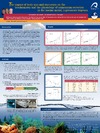Identificador persistente para citar o vincular este elemento:
https://accedacris.ulpgc.es/jspui/handle/10553/7221
| Título: | The impact of body size and starvation on the biochemistry and the physiology of ammonium excretion in the marine mysid, "Leptomysis lingvura" | Autores/as: | Fernández-Urruzola, Igor Packard, Theodore T. Gómez, May |
Clasificación UNESCO: | 251001 Oceanografía biológica | Palabras clave: | Glutamate dehydrogenase Ammonium excretion Leptomysis lingvura Starvation Body size |
Fecha de publicación: | 2011 | Resumen: | Ammonium (NH4+) release by bacterial remineralization and heterotrophic grazers determines the regenerated fraction of phytoplankton productivity, so the measurement of NH4+ excretion in marine organisms is necessary to characterize both the magnitude and the efficiency of the nitrogen cycle. Glutamate dehydrogenase (GDH) is largely responsible for NH4+ formation in crustaceans and consequently should be useful in estimating NH4+ excretion by marine zooplankton.<br />Here, we address body size and starvation as sources of variability on the GDH to NH4+ excretion ratio (GDH/RNH4+). We found a strong correlation between the RNH4+ and the GDH activity (r2 = 0.87, n = 41) during growth. Since GDH activity maintained a linear relation (b = 0.93) and RNH4+ scaled exponentially (b =0.55) in well fed mysids, the GDH/RNH4+ ratio increased with size. However, the magnitude of its variation increased even more when adult mysids were starved. In this case, the GDH/RNH4+ ratio ranged from 11.23 to 102.41. | URI: | https://accedacris.ulpgc.es/handle/10553/7221 | Fuente: | 5th International Zooplankton Symposium, Pucón, Chile, Marzo, 2011 |
| Colección: | Póster de congreso |
Visitas
41
actualizado el 27-ene-2024
Descargas
14
actualizado el 27-ene-2024
Google ScholarTM
Verifica
Comparte
Exporta metadatos
Este elemento está sujeto a una licencia Licencia Creative Commons

